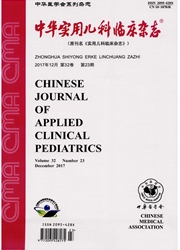

 中文摘要:
中文摘要:
目的探讨过敏性紫癜(HSP)患儿的肠道菌群结构及多样性变化和粪便菌群与黏膜菌群结构及多样性的差异。方法收集47例过敏性紫癜患儿粪便样本和其中7例腹型患儿的结肠黏膜样本,以11例健康儿童粪便样本为对照,采用试剂盒提取法提取样本DNA并进行高通量测序,对测序结果进行生物学信息分析。结果 HSP患儿与健康儿童粪便菌群存在结构差异,在门水平两组均以厚壁菌门(47.10%、57.75%),变形菌门(23.04%、10.13%),拟杆菌门(22.81%、21.74%)为主要优势菌群,在科水平,均以肠杆菌科(17.60%、8.72%)、拟杆菌科(18.90%、21.65%)、瘤胃菌科(16.44%、28.93%)、毛螺菌科(11.55%、10.74%)有较高的丰度。HSP患儿粪便菌群中变形菌门、欧文氏菌属(从目到属)、拟杆菌属-uniformis种、巨单胞菌属、肠球菌属(从科到属)丰度高于对照组健康儿童,而双歧杆菌属(从目到属)、链球菌属(从目到属)、普拉梭菌种(从科到种)丰度低于对照组健康儿童。腹型患儿粪便菌群多样性高于黏膜菌群;在门水平,粪便菌群以厚壁菌门(53.64%)、变形菌门(33.65%)、拟杆菌门(9.24%)丰度较高,黏膜菌群以变形菌门(88.13%)丰度最高,在科水平,粪便菌群以肠杆菌科(27.18%)、瘤胃菌科(15.58%)、毛螺菌科(12.31%)为优势菌科,黏膜菌群以肠杆菌科(87.19%)为优势菌科;粪便菌群以双歧杆菌属(从门到属)、链球菌属(从门到属)、动性球菌科(从门到科)、丹毒丝菌科(从门到科)、梭菌科(从门到科)、瘤胃菌科(从门到科)、毛螺菌科(从门到科)为主要特征差异细菌种类,结肠黏膜菌群以欧文氏菌属(从门到属)为主要特征差异细菌种类。结论 HSP患儿粪便菌群病原菌或机会致病菌增多而有益菌减少,腹型HSP患儿黏膜菌群与粪便菌群存在结构和多样性差异。
 英文摘要:
英文摘要:
Objective To study the structure and diversity of intestinal flora and structure and diversity difference of fecal flora and mucosal flora in children with Henoch-Schnlein purpura( HSP). Methods Stool samples from 47 children with HSP were collected,including colon mucosa samples from 7 HSP children with abdominal symptoms,and stool samples from 11 healthy children were used as controls.DNA of samples was extracted using extraction kit method and subjected to high throughput sequencing,and biological information analysis was conducted on results. Results Structure of fecal flora was different between HSP children and healthy children. Predominant bacteria in two groups were Firmicutes( 47. 10%,57. 75%),Proteobacteria( 23. 04%,10. 13%) and Bacteroidetes( 22. 81%,21. 74%) at phylum,and Enterobacteriaceae(17. 60%,8. 72%),Bacteroidaceae(18. 90%,21. 65%),Ruminococcaceae(16. 44%,28. 93%),Lachnospiraceae(11. 55%,10. 74%) were more abundant at family. Abundances of Proteobacteria,Erwinia( from order to family),B-uniformis,Megamonas and Enterococcus( from family to genus) in fecal flora of HSP children were higher than those of children in the control group,while abundances of Streptococcus( from order to family),Bifidobacterium( from order to family) and F. prausnitzii( from family to species) in HSP children were lower than those in children in the control group. Diversity of fecal flora was higher than that of mucosal flora in HSP children with abdominal symptoms. Abundances of Firmicutes( 53. 64%), Proteobacteria( 33. 65%) and Bacteroidetes(9. 24%) were higher in fecal flora at phylum,while abundance of Proteobacteria(88. 13%) was higher in mucosal flora.Predominant bacteria in fecal flora were Enterobacteriales(27. 18%),Ruminococcaceae(15. 58%) and Lachnospiraceae(12. 31%) at family,while predominant bacteria in mucosal flora was Enterobacteriaceae( 87. 19%). Bifidobacterium( from phylum to genus),Streptococcus( from phylum t
 同期刊论文项目
同期刊论文项目
 同项目期刊论文
同项目期刊论文
 期刊信息
期刊信息
